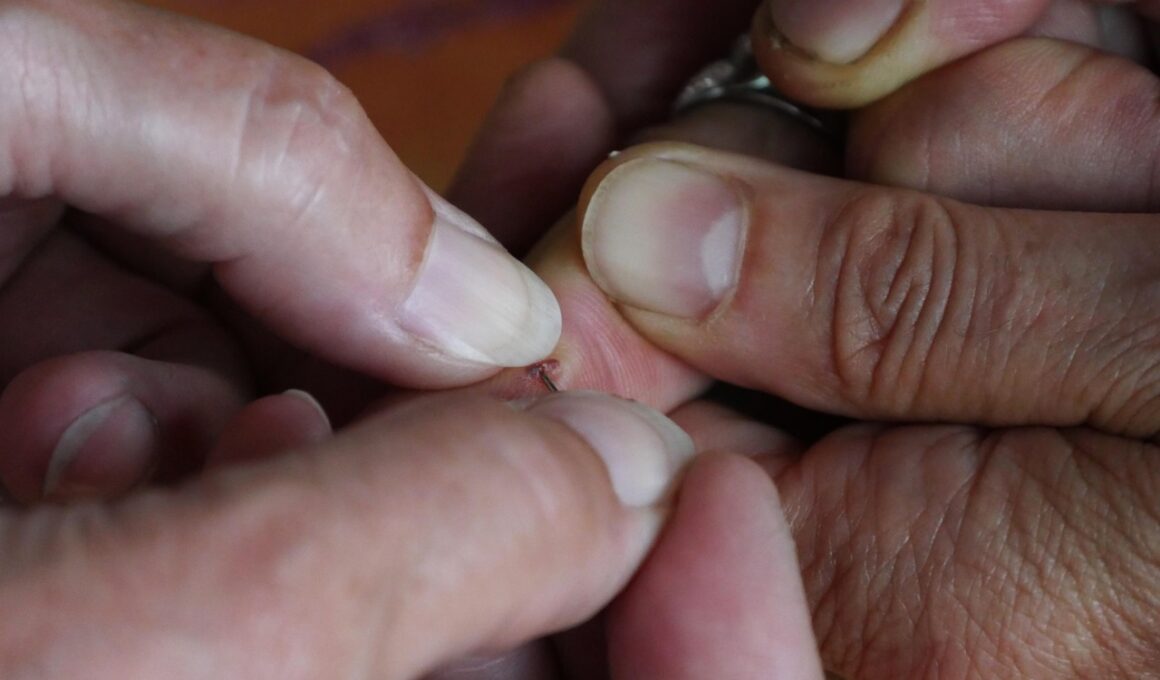First Aid Protocols for Nosebleeds in Fighting Contexts
Nosebleeds are common injuries that may occur during a fight or self-defense situation. Understanding how to manage a nosebleed effectively is vital for anyone participating in combat sports or self-defense training. Nosebleeds can be caused by various factors like trauma, excessive force, or even environmental conditions affecting the nose. Recognizing a nosebleed’s onset is crucial, as immediate action can prevent further complications. Typically, a nosebleed may present with a sudden rush of blood from one or both nostrils, and sometimes, it can be accompanied by pain or pressure in the nasal area. The first step is to stay calm, as panic can exacerbate the situation. Lean forward to prevent swallowing blood, which can lead to nausea or coughing. Pinching the nose helps reduce blood flow. Applying ice to the back of the neck may also be useful to constrict blood vessels. Avoid leaning back, as this might block the airway. Maintain pressure on the nostrils for 5 to 10 minutes, checking to see if bleeding has ceased to ensure effective management in self-defense scenarios.
Aside from immediate pressure techniques, it is essential to distinguish between simple and severe nosebleeds. A simple nosebleed, often called an epitaxis, occurs without significant trauma, while severe nosebleeds may indicate damage to deeper nasal structures or other conditions. For individuals engaged in self-defense training or combat sports, awareness of the severity is paramount. In combat sports, heavy punches might lead to a severe nosebleed, requiring a higher level of attention. In that case, after applying basic first aid, it’s advisable to seek medical assistance for further evaluation, especially if the bleeding persists. Signs that warrant immediate professional help include excessive blood loss, difficulty breathing, or if the fighter took a heavy blow to the head. Additionally, if the nosebleed occurs frequently, it could indicate underlying health issues, necessitating a medical consultation. Learning first aid protocols is crucial, as the ability to act quickly and efficiently can make a significant difference in self-defense situations. Staying informed about such injuries ensures better preparedness during potential conflicts.
Steps for Immediate Management of Nosebleeds
To handle a nosebleed effectively, follow these established steps. First, instruct the affected individual to sit down, ensuring that they lean slightly forward. This position prevents the blood from running down the throat and reduces the risk of choking or vomiting. Next, gently pinch the soft part of the nose, just below the bridge, using thumb and index fingers. This pressure should be maintained continuously for about 5 to 10 minutes while they breathe through their mouth. It is important to remember not to tilt the head back, as it can lead to swallowed blood and increased irritation in the stomach. Offer ice packs if available, as applying ice can constrict blood vessels, reducing the bleeding. After the 10 minutes have passed, slowly release the pressure to check if the bleeding has stopped. If the nose is still bleeding, apply gentle pressure again for another 10 minutes. In addition, try to avoid blowing the nose for several hours, as this can aggravate the situation and trigger further bleeding.
In self-defense training and combat sports, preparation is key when it comes to preventing injuries such as nosebleeds. By wearing protective gear, including headgear or face guards, fighters may reduce the likelihood of injuries. It’s essential to understand the mechanics of the sport and techniques related to positioning to avoid certain strikes to the face that can lead to nosebleeds. However, accidents happen, and knowing how to react promptly is as significant as prevention. Taking the time to learn basic first aid techniques, including those for managing nosebleeds, can be invaluable. Consider practicing these techniques regularly, possibly integrating first aid scenario training into regular self-defense classes. This preparation helps fighters to feel more confident and capable of handling medical emergencies. Encourage training participants to familiarize themselves with each other’s medical history, noting any conditions that may predispose them to frequent nosebleeds. This information can be crucial for effective team response during fights. Ultimately, being prepared reduces fear and increases ease when facing potential injuries during training or competition.
Long-Term Solutions and Prevention Strategies
For those frequently experiencing nosebleeds, there are long-term solutions to consider. Maintaining proper hydration is vital since dry nasal membranes can lead to increased susceptibility to bleeds. Using saline nasal sprays can help keep the nasal passages moist. It’s also beneficial to maintain a humid environment, especially during colder months. If nosebleeds occur due to allergies or irritants, addressing these underlying issues can significantly reduce the frequency. Additionally, avoiding situations where severe trauma could happen is essential, particularly during vigorous training or combat. Regular check-ups with an ENT specialist may help identify any anatomical issues contributing to recurrent nosebleeds or any prescribed treatments. Allergy evaluations can also provide insights into preventative measures, such as medications or lifestyle modifications. In combat sports, training on recognizing when it’s appropriate to take time off due to a minor injury must be emphasized, as risking worsened injuries can lead to further complications. A holistic approach to both training and long-term care helps ensure that fighters are physically and mentally prepared to minimize injuries.
Incorporating knowledge about first aid and emergency response into self-defense education is critical. Instructors should prioritize teaching students about the importance of managing injuries like nosebleeds. By integrating these discussions into training sessions, students will develop an awareness that extends beyond fighting techniques. Simulation drills can be an effective method for reinforcing first aid knowledge. Practicing how to effectively stop a nosebleed and caring for injured teammates fosters teamwork and preparedness. Mock scenarios can be developed where students simulate injuries and practice responding under pressure, emphasizing communication and quick decision-making. This approach not only builds confidence in handling injuries but also strengthens the collective response of participants. Ensuring students know how to protect themselves, and others during an injury enhances their overall training experience. Additionally, providing resources, such as printed leaflets detailing first aid protocols, can be invaluable. These resources can serve as instructional guides, helping fighters remember necessary steps for further application during training or real-life situations. A robust emphasis on injury management contributes to developing well-rounded, informed fighters.
Conclusion on Nosebleed Management in Self-Defense
In conclusion, understanding the essential steps needed to manage nosebleeds effectively is a valuable skill for anyone involved in self-defense training and combat sports. Given the potential for injury during contact sports, knowledge and preparedness play crucial roles in ensuring the safety of participants. Alongside learning techniques to manage injuries, practicing first aid responses creates professionals who can act promptly when required. Immediate care can minimize the risk of complications and preserve overall health for participants. Encouraging responsible behavior during training, including wearing protective gear and recognizing when to stop can prevent serious injuries. Awareness around the seriousness of certain bleeding incidents should lead to a more considerate approach toward health and safety. Ultimately, equipping self-defense practitioners with comprehensive first aid skills, particularly for cases like nosebleeds, reflects a commitment to fostering a safe training environment. As individuals learn the protocols and gain experience, they grow into well-prepared fighters ready to navigate any situation responsibly. Investing time in understanding first aid is an investment in health, safety, and overall performance in all self-defense scenarios.
Combat sports, martial arts, and self-defense scenarios often present unique situations in which injuries may arise, necessitating an understanding of first aid. In these contexts, nosebleeds can frequently occur as a direct consequence of physical impact. Understanding the implications of such injuries allows practitioners to manage them effectively, both for themselves and for others around them. Comprehensive training will not only prepare you to handle the physical aspects of self-defense but also empower you with the necessary knowledge to act appropriately in various injury situations. A fighter who can monitor their health and respond efficiently to accidents stands out from the rest. By prioritizing health, learning basic first aid, and becoming well versed in the appropriate response techniques, fighters bolster their readiness for any potential challenges they may face in the arena. The ability to maintain composure and efficiently handle medical situations fosters strong leadership among team members. Awareness around managing injuries also introduces a sense of community and support, as practitioners look out for each other during training. Therefore, embracing first aid protocols not only promotes personal safety but also enhances camaraderie and mutual respect among peers.


